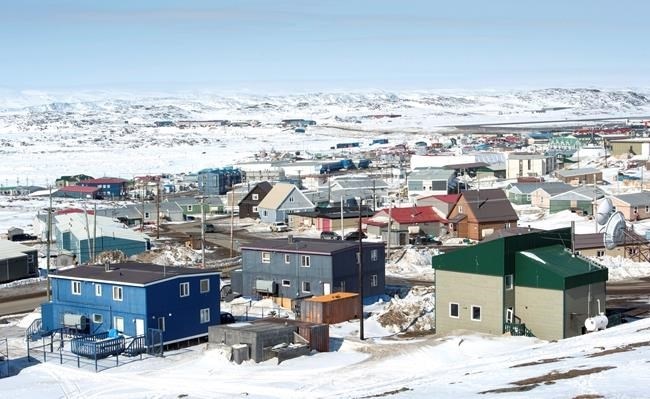
FILE PHOTO - A scene from Iqaluit, Nunavut, Saturday, April 25, 2015. The latest release of data from the 2016 census shows Canada's Indigenous population is booming, more immigrants are settling in the Prairies and home ownership rates across the country are relatively stable.
Image Credit: THE CANADIAN PRESS/Paul Chiasson
October 25, 2017 - 10:30 AM
OTTAWA - Increasingly, the face of the average Canadian is anything but average.
There was plenty of diversity on display in Wednesday's deposit of Statistics Canada census data, including 250 different ethnic origins across the country, and hints of more to come: visible minorities could comprise fully one-third of Canadians by 2036 as immigration drives population growth not just in the cities, but across the country.
The release marks just the latest — and second-to-last — in a year-long series of statistical snapshots of the Canadian condition, one that also heralded the return of data from the much-maligned long-form census for the first time in a decade.
The census portrait began with a population boom out West and a commensurate spike in the number of households. Wednesday's release showed a similar trend for two groups: the largest overall increase in the Indigenous population was in western Canada over the last decade, while the share of recent immigrants to the Prairies more than doubled over the last 15 years.
"Immigrants are diffusing across the country," said Michael Haan, a sociology professor at Western University in London, Ont.
READ MORE: Home ownership rates take historic dip as more Canadians opt to rent
"What it's forcing us to do, collectively, is think about our entire nation as being composed of immigrants, rather than just major cities."
Nearly half of major metropolitan areas are comprised of visible minorities, noticeably Toronto and Vancouver, said Doug Norris, chief demographer at Environics Analytics. But the figures are also on the rise in places like Saskatoon, Regina, Winnipeg, and Calgary, he added.
"Places that people didn't think were culturally diverse are becoming now culturally diverse."
Statistics Canada has been saying through the census that Canada is becoming more diverse with the latest data dump showing that more immigrants are arriving from Africa than ever before, placing ahead of Europe for the first time.
"The challenge is to make sure that they fully integrate into Canadian society. So there are challenges coming with this diversity as well," said Jean-Pierre Corbet, assistant director of the social and aboriginal division at Statistics Canada.
READ MORE: Indigenous Peoples paradox: Aboriginals younger, but getting old
Statistics Canada has already documented a historically high number of seniors — a demographic soon to see ever-increasing numbers of Indigenous people — as well as children staying at home longer, more generations than ever living under Canadian roofs, a moderate increase in income levels and the changing face of the working poor.
Wednesday's revelations included word that younger Canadians are opting less for home ownership, choosing instead the rental route as housing prices climb ever higher.
Aboriginal children face a poverty rate of just over 30 per cent, compared to 17 per cent in the wider population, the census found.
And more than 7.6 million Canadians identify as a visible minority, representing 22.3 per cent, just over one-fifth of the national population. That's an almost five-fold increase from 1981, when visible minorities made up 4.7 per cent of the population.
"What comes through is diversity across all characteristics," said Norris, who spent three decades at Statistics Canada.
READ MORE: Latest census numbers showcase Canada's ever-evolving ethnic diversity
Diversity is no stranger to the Cree Nation of Chisasibi.
According to the census, the small community on the eastern coast of James Bay has residents whose ethnic origins include the Caribbean, South America and Africa. The economic development officer for the band administration is from Sri Lanka, and has been in the community for almost a decade.
The community welcomes them all, but finding housing is becoming ever more difficult.
Chief David Bobbish said there is a need for 400 more homes in the community to ease overcrowding. Government spending only helps build about six houses a year, Bobbish added, leaving many families packed into too-small homes — a common plight across Indigenous communities in Canada.
"You don't have any choice but to live in a house with other people," he said. "Even evictions are difficult. You cannot evict people if they have nowhere to go."
READ MORE: Aging Aboriginals pose new fiscal, social challenge for government: census
In Chisasibi, the community is looking for new ways to build homes and promote private ownership — efforts that may not get caught in the latest tranche of statistics.
Other communities, Indigenous and non-Indigenous alike, are looking for ways to make it easier for people to afford a roof over their head. Bobbish says addressing an acute housing shortage in his community could have wider ramifications.
"There are houses that have 10 or 15 people living under one roof. This is what creates a lot of social issues."
News from © The Canadian Press, 2017